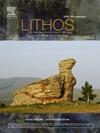The interplay of crystal fractionation, magma recharge, assimilation and mixing in Archean volcanic systems revealed in the geochemical diversity of the Deloro assemblage, Abitibi Greenstone Belt
IF 2.5
2区 地球科学
Q2 GEOCHEMISTRY & GEOPHYSICS
引用次数: 0
Abstract
Volcanic rocks from greenstone belts represent major records of Archean geologic history. One such belt, the Abitibi Greenstone Belt, which forms the eastern part of the Abitibi-Wawa Subprovince (one of several terranes in the Superior Province, Canada) is notable for its relatively high proportion of supracrustal rocks and rich mineral endowment. Greenstone belt volcanic rocks do, however, present a challenge for geochemical modelling due to the variable extent to which their primary signatures can be overprinted by hydrothermal alteration and metamorphism. Nevertheless, the use of immobile elements for data exploration, and focussing on the least-altered samples for petrogenetic modelling, can overcome these challenges. Furthermore, modern modelling tools, like the Magma Chamber Simulator, offer unprecedented opportunities to constrain the origin and evolution of volcanic rocks, such as the Deloro Assemblage in the Abitibi Greenstone Belt, and thereby gain insights into Archean petrogenesis. The 2734–2724 Ma Deloro Assemblage is widespread, well sampled, geochemically diverse, and of economic interest due to a rich endowment of volcanogenic massive sulphide deposits. A large geochemical compilation and petrogenetic modelling using the Magma Chamber Simulator demonstrates that the major element diversity can be explained through a combination of processes, using a tholeiitic basaltic parental magma at approximately 3 kbar and a wallrock of average SE Superior Province TTG as a contaminant. This modelling highlights the roles not just of fractional crystallisation and assimilation, but also the previously unrecognised role of magma recharge in contributing to the geochemical diversity of the Abitibi volcanic systems. Additionally, the modelling provides constraints on what ranges of oxygen fugacities and parental magma water contents are suitable. The trace element evolutions of these models clarify the different petrogenetic pathways that give rise to the Deloro Assemblage rocks. We show that the volcanic rocks can be organized into nine geochemical groups, mostly based on a Th/Yb versus Yb/Ti diagram. Furthermore, trace element modelling illustrates the utility of this diagram for differentiating (a) between open- versus closed-system behaviour, and (b) between different types of open-system processes. The most primitive group, Tholeiitic basalts, has trace element patterns that suggest melting of primitive mantle at a range of depths. The Tholeiitic basalts, Transitional intermediate group, Tholeiitic dacites and Tholeiitic rhyolites record progressive evolution via fractional crystallisation and magma recharge. In contrast, coupling assimilation to fractional crystallisation accounts for the progression from Tholeiitic basalts to High-Th basalts and further onwards to the Calc-alkaline andesites, Calc-alkaline dacites and Calc-alkaline rhyolites. The high Th/Yb, low Yb/Ti character of the HREE-depleted intermediate group cannot be explained through AFC; rather these samples are part of a simple mixing trend between the tholeiitic basaltic parent magma and the TTG composition. In light of the geochemical groups and their petrogenesis, a general association between VMS deposits and extensive fractionation (particularly Tholeiitic rhyolites) can be observed. In contrast, the HREE-depleted intermediate group is infertile.
阿比提比绿岩带Deloro组合的地球化学多样性揭示了太古宙火山体系中晶体分馏、岩浆补给、同化和混合的相互作用
绿岩带火山岩是太古宙地质历史的重要记录。阿比提比绿岩带是其中之一,它形成了阿比提比-瓦瓦副省(加拿大苏必里尔省的几个地体之一)的东部,以其相对较高的表壳岩石比例和丰富的矿物禀养而闻名。然而,由于热液蚀变和变质作用在不同程度上叠加了绿岩带火山岩的原始特征,因此对地球化学模拟提出了挑战。然而,使用固定元素进行数据探索,并专注于最小变化样本进行岩石成因建模,可以克服这些挑战。此外,岩浆室模拟器等现代建模工具为约束火山岩的起源和演化提供了前所未有的机会,例如阿比提比绿岩带的Deloro组合,从而深入了解太古宙岩石成因。2734-2724 Ma Deloro组合分布广泛,采样良好,地球化学多样性,由于丰富的火山块状硫化物矿床,具有经济价值。利用岩浆室模拟器进行的大型地球化学汇编和岩石成因模拟表明,主要元素多样性可以通过多种过程的组合来解释,其中使用约3 kbar的拉斑玄武岩母岩浆和平均SE Superior省TTG的围岩作为污染物。这个模型不仅强调了部分结晶和同化的作用,而且还强调了岩浆补给在促进阿比提比火山系统的地球化学多样性方面以前未被认识到的作用。此外,该模型还对氧逸度和母岩浆含水量的合适范围提供了约束。这些模型的微量元素演化阐明了形成Deloro组合岩石的不同成岩途径。我们发现火山岩可以被组织成9个地球化学组,主要基于Th/Yb和Yb/Ti图。此外,微量元素建模说明了该图在区分(a)开放与封闭系统行为之间以及(b)不同类型的开放系统过程之间的效用。最原始的组,拉斑玄武岩,有微量元素模式,表明在一定深度的原始地幔融化。拉斑玄武岩、过渡中间群、拉斑英安岩和拉斑流纹岩记录了分晶和岩浆补给的渐进演化过程。相比之下,耦合同化与分块结晶作用解释了从拉斑玄武岩到高th玄武岩,再到钙碱性安山岩、钙碱性英安岩和钙碱性流纹岩的演化过程。3 -贫中间组高Th/Yb、低Yb/Ti的特征不能用AFC解释;相反,这些样品是拉斑玄武岩母岩浆与TTG成分混合趋势的一部分。根据地球化学类群及其成因,VMS矿床与广泛分馏作用(特别是拉斑流纹岩)具有普遍联系。相反,缺乏3 - e的中间组是不育的。
本文章由计算机程序翻译,如有差异,请以英文原文为准。
求助全文
约1分钟内获得全文
求助全文
来源期刊

Lithos
地学-地球化学与地球物理
CiteScore
6.80
自引率
11.40%
发文量
286
审稿时长
3.5 months
期刊介绍:
Lithos publishes original research papers on the petrology, geochemistry and petrogenesis of igneous and metamorphic rocks. Papers on mineralogy/mineral physics related to petrology and petrogenetic problems are also welcomed.
 求助内容:
求助内容: 应助结果提醒方式:
应助结果提醒方式:


